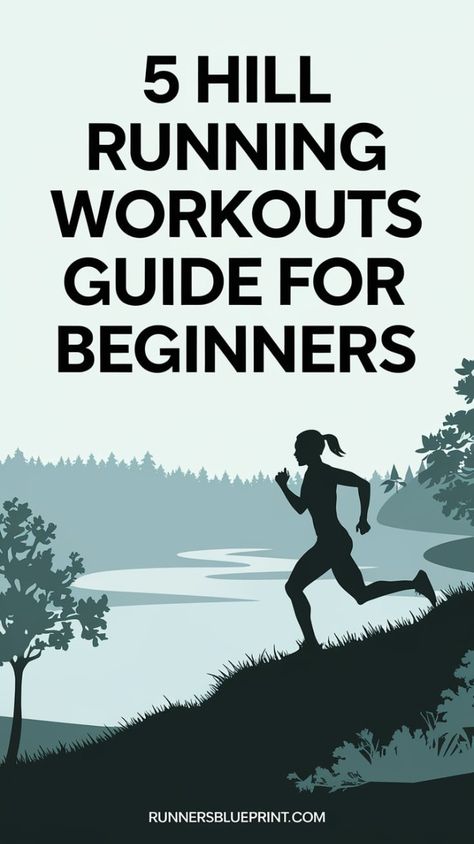Hill running? It’s a challenge that tests every runner, and trust me, it’s tough but totally worth the effort.
Many runners have a love-hate relationship with hills — they’re daunting yet so rewarding
If you tend to avoid hills because they feel like too much work or just don’t know where to start, this post is for you.
I’ll walk you through some simple steps to master those hills and enjoy them!
Let’s get to it.
Why You Should Love Hill Running
I get it—hills are hard. But they can be a game-changer for your running. Running uphill works out your glutes, hamstrings, calves, and core—muscles that don’t always get attention on flat routes.
You’ll also be driving your knees up more and using your arms to power yourself forward, giving your entire body a workout.
Hill running builds strength, boosts cardiovascular fitness, and increases running efficiency. Plus, it boosts your VO2 max, enhancing the maximum oxygen your body can utilize during intense runs.
Not only does hill running build muscle, but it’s also a fantastic way to improve your cardiovascular fitness. My heart rate shot up every time I hit a hill, and I could feel my endurance increasing over time.
But I won’t sugarcoat it. Hill running is tough, especially at first. That’s why you need to be smart about how you approach it.
The Science-Backed Benefits of Hill Running
Hill running isn’t just about powering up inclines—it’s a powerhouse workout with some pretty awesome benefits for strength, endurance, and overall running efficiency. And recent research backs up what many of us have felt firsthand on those tough climbs!
Builds Muscular Strength and Power
Running uphill forces you to work against gravity, which engages your glutes, quads, hamstrings, and calves even more than flat terrain does. According to a study published in Sports Medicine, hill running activates the lower body muscles in a way similar to resistance training. The repetitive, high-intensity muscle engagement builds strength and power, especially in the legs and core, which translates to faster speeds on flat ground. Think of hill running as a “secret weapon” for making those muscles resilient and strong for race day.
Boosts Cardiovascular Endurance
Research shows that hill running enhances VO2 max—your body’s ability to utilize oxygen—far more efficiently than flat-surface running. A study found that just six weeks of hill training significantly improved runners’ aerobic capacity. Why? Because running uphill requires your body to work harder and your heart rate to spike, pushing your cardiovascular system to new limits. Adding hills to your routine once a week can help you tackle longer distances with less fatigue.
Improves Running Form and Efficiency
One of the often-overlooked perks of hill running is its impact on form. Studies suggest that tackling inclines can naturally improve biomechanics by promoting a higher knee lift, proper foot strike, and stronger arm drive. Uphill running encourages a forward-leaning posture, which is ideal for all running surfaces. The Journal of Applied Biomechanics found that runners who included hill sprints in their training showed better stride mechanics and greater running efficiency. So, if you’re looking to smooth out your form, hills are the way to go!
How to Conquer Hill Running
Once you’re ready to add hills into your routine, a bit of strategy is involved. One mistake I made early on was trying to keep the same pace going uphill that I would on flat ground.
I’d gas out halfway up and stop to catch my breath. I realized it’s all about maintaining effort, not pace.
Let the hill slow you down, but keep the intensity steady.
Let’s dive a little deeper.
Find a Good Hill
New to hill running? Start easy. Look for a hill that’s about 100-200 meters long with a gentle 3-5% incline—enough to give you a challenge without killing your form.
If you don’t live near hills, don’t worry—treadmills with incline settings can simulate the experience. I often used this trick during the winter when the streets were too icy for hill sprints.
The Warm-up & Cool-Down
This might sound basic, but never skip your warm-up before hitting the hills. The last thing you want is to pull a muscle because you didn’t prepare properly.
Start with 5-10 minutes of easy jogging on a flat surface, followed by dynamic stretches like leg swings, lunges, and high knees. This will loosen you up and flow blood to the right muscles. After the workout, cool down with an easy 10-minute jog and some stretches to help prevent soreness.
Start Small – The Ideal Session
My first proper hill workout was a revelation. I kept it simple: running up the hill for 10 to 20 seconds and walking back down to recover. I repeated that for about 15 minutes, and I was wiped out by the end of the session. But after a few weeks, I noticed the climbs weren’t as hard as they used to be, and I could run for longer stretches without walking.
You should start small if it’s your first time running hills. Here’s an easy session to get you going:
- Warm-up: Jog for 5-10 minutes on flat ground.
- Run the hill: Run uphill at an easy pace for 10-20 seconds.
- Walk down: Walk back down to recover.
- Repeat: Continue this cycle for 15-20 minutes or as long as you feel strong.
- Cool-down: Finish with a 10-minute easy jog.
Control Your Body
Running hills requires rhythm and control. You’ll burn out quickly if you try to power through and keep the same pace as on flat ground. Instead, focus on maintaining effort, not speed.
Allow the hill to dictate your speed, focusing on maintaining a steady effort instead. This helps you conserve energy while still getting the benefits of hill training.
When to Start
Hill running is intense, so don’t jump into it right away if you’re new to running. Make sure you’ve built a solid base first. I recommend having 2-3 months of regular running (3-4 days a week, averaging 14-16 miles per week) before you start hill training. Once you have that base, add one hill workout to your weekly routine.
The Exact Pace
Aim to run at 70-80% of your maximum effort for your first hill workout. You don’t need to push yourself too hard, but the pace should still feel challenging.
I suggest keeping your first hill sessions around 15 minutes to ease into it.
One of the biggest mistakes I made was trying to keep my flat-ground pace going uphill. I’d huff and puff and feel like I was running through quicksand. It took me a while to figure out that hills aren’t about keeping pace—they’re about keeping effort steady.
Once I made that shift, hills became manageable. Now, I let the hill dictate my pace, and I focus on maintaining good form and steady breathing. It’s less about speed and more about building strength and resilience
The Very First Few Steps
After warming up, find a hill around 100-150 meters long. Run uphill at a 5K effort pace, but don’t worry too much about speed.
Focus on maintaining the same effort you use on flat ground. Challenge yourself, but don’t let your form fall apart. Keep it smooth and controlled.

The Uphill Form
Form is key when it comes to hill running. When I started, I leaned forward too much, thinking it would make the climb easier. It didn’t. I learned to stay upright, keep my core engaged, and use my arms to help drive me up the hill.
Shortening my stride also made a huge difference—I’d try to power through with big steps, but smaller, quicker strides allowed me to keep my energy up without losing my form.
Here are a few tips to help point you in the right direction.
- The proper alignment. Keep your hips, chest, and head in line, staying upright as you climb. Lean in a bit from the hips—just don’t stoop. I learned the hard way that slumping forward only makes the hill harder.
- The head. Keep your head up, eyes about 10-20 feet ahead—don’t stare at your feet or the top of the hill. I like to focus on a spot just in front of me; it helps keep my momentum and focus in check..
- The right posture. Engage your core muscles, keep your back straight and chest out, and hold your head up. This should open your airways, allowing for maximum oxygen delivery—Oh, trust me, you will need all the oxygen you can get.
- The arms. Keep your arms bent at a 90-degree angle. They should move forward and backward, rotating at the shoulder, not side to side.
- Arm swings. Swing your elbows backward from your shoulder to generate enough momentum to help power up the hill. Imagine you’re punching someone in front of you with an uppercut. This might seem exaggerated, but it works.
- Stride rate. As you go up, shorten your stride instead of extending it as if trying to power up the hill. The feet should be kept low to the ground the entire time.
The Downhill Technique
Running downhill can be just as tricky as going up.
I used to think that once I made it to the top, the hard part was over. But running downhill isn’t something you should take lightly. I ran down too fast the first few times and felt it in my knees afterward.
Here’s how to build proper downhill form.
- Avoid overstriding. Let gravity carry you downward and use it to step up the pace. Take short and quick steps, increasing your stride rate.
- The right landing. Focus on landing on your forefoot. Landing on the heels creates a braking effect, which jars the entire body and slows you down. Land as light as possible, preferably on the mid to forefoot.
- Keep it under control. Try to keep a stride turnover and effort that’s consistent with the rest of your workout.
The Five Hill Workouts Runners Should Do
Let me share with you my favorite five hill workouts that are game-changers for any runner, from sprinters to marathon enthusiasts.
1. Short Hill Sprints
Find a hill around 50-200 feet long with a nice, steep 5-15% incline. Sprint up as hard as you can for less than 30 seconds, and then walk back down. It’s perfect for building explosive strength, especially if you’re a sprinter
These sprints activate all types of muscle fibers and enhance the maximal stroke volume of your heart, making your cardiovascular system more efficient.
My first real hill workout was a short, steep hill near my house. I committed to running up it for 10 seconds at a time, walking down to recover, and repeating the process for 15 minutes. It might not sound like much, but by the end, my legs were toast!
But I stuck with it.
Every week, I added a few more seconds, and before long, I could tackle that hill with ease
The Routine
Start with six to eight sprints up the steepest part of the hill you can manage, recover on the way down, and gradually increase the number of repeats as you progress.
2. Long Hill Repeats
Long hill repeats help build endurance and aerobic strength. Try running up a longer hill (half a mile or so) at a pace you could keep for a 10K. These are a bit of a grind but incredibly rewarding
Your pace should be challenging yet sustainable, similar to or slightly faster than your 10K race pace. These repeats are excellent for building endurance and improving your lactate threshold, which is crucial for longer distances.
The Routine
Warm up with a gentle jog and dynamic stretches. Attack the hill for three to five minutes at a time, aiming to maintain an effort level around 7 out of 10. Jog down for recovery and repeat three to four times.
3. Long Hill Runs
For those longer, steady-state efforts, long hill runs are ideal. Depending on your fitness and goals, these runs can range from three to ten miles. They primarily engage your slow-twitch muscle fibers, which are essential for endurance. This type of workout is a staple for distance runners and invaluable if your race course features hills.
The Routine
Start incorporating gradual uphill sections into your longer runs. As you build strength, increase the uphill distance. Try continuous uphill running on a long ascent for 45 to 90 minutes for a real challenge.
4. Downhill Running
Don’t underestimate the downhill! It’s great for learning control and building up your quads. Start with a gentle slope, and focus on landing lightly, keeping those steps quick and steady. It strengthens your quadriceps through eccentric contractions and teaches you to manage your pace effectively.
The Routine
I’d recommend doing a downhill session at least once a month. Start with a gentle slope and progress to steeper descents. Use the downhill sections to practice running fast while maintaining control, and focus on engaging your core to stabilize your descent.
5. Hill Bounding
To specifically target running strength and power, hill bounding is your go-to workout. This involves exaggerated, powerful strides that focus on driving each knee high and pushing off strongly with each foot. It’s fantastic for enhancing your push-off power and overall running efficiency.
The Routine
Only add hill bounding to your routine once you’ve established a solid cardiovascular and muscular endurance base. Start with a moderate incline and perform drills like exaggerated strides and one-leg hops, always focusing on form and power.
4-Week Beginner Hill Running Progression Plan
If you’re new to hill running, this four-week progression plan will help you ease into it without overwhelming your muscles.
Hill workouts are all about building strength and endurance gradually, so we’re starting slow and increasing the intensity bit by bit.
Week 1: Getting Comfortable with Hills
Workout: 2 rounds of short hill repeats
Incline: Light incline (4-5%)
Goal: Focus on form—keep your core engaged, lean slightly forward, and drive your arms.
Instructions: Find a hill with a manageable incline. Run up for about 20-30 seconds at a steady pace, focusing on good form. Walk back down to recover. Complete 2 rounds with plenty of rest in between. This week is all about getting a feel for running uphill without rushing.
Week 2: Adding a Bit of Intensity
Workout: 3 rounds of hill repeats
Incline: Moderate incline (5-7%)
Goal: Start building strength and confidence.
Instructions: This week, increase the number of rounds to 3 and find a slightly steeper hill. Keep focusing on form, but aim to challenge yourself a bit more. Run up for 30-40 seconds at a controlled, consistent pace. Walk back down to recover fully between each round.
Week 3: Extending the Distance
Workout: 4 rounds of hill repeats
Incline: Moderate incline (5-7%)
Goal: Build endurance with longer repeats.
Instructions: Increase your rounds to 4 and slightly extend the distance—aim for 40-50 seconds of uphill running. This week will push your endurance, so stay steady on the pace and don’t worry if it feels tough. Walk down between rounds, focusing on keeping your breathing controlled.
Week 4: Adding Variety to the Challenge
Workout: 5 rounds of varied hill repeats
Incline: Mix of light and moderate inclines (4-8%)
Goal: Introduce variety and build a balanced foundation.
Instructions: This week, aim for 5 rounds and try incorporating different inclines. Start on a lighter incline for the first two rounds, then shift to a steeper incline for the final three rounds. Run each repeat for about 40-50 seconds, focusing on maintaining form as you tackle different incline levels. Walk back down to recover and reflect on how far you’ve come!
How Much is Hill Training
Starting, schedule one hill session every 7 to 14 days.
Add time to your repeats and an extra climb as you get fitter.
The number of hill reps depends on your fitness experience and training goals.
You’re good to go if you’re staying within your fitness level.
As you get fitter, expect to perform anywhere from eight to ten repeats, depending on your goals and level of fitness.
Just whatever you do, whenever you plan hill workouts, do not do it more than once a week.
What’s more?
Mix up your hill workouts—some steep and short, and other longer ones with less challenging inclines.
Hill running might seem intimidating at first, but with the right approach, it can become one of your favorite parts of training. Focus on good form, control your effort, and gradually build your strength. In no time, you’ll be tackling hills like a pro.
Keep at it, and remember—every hill you conquer makes you a stronger, faster runner!







